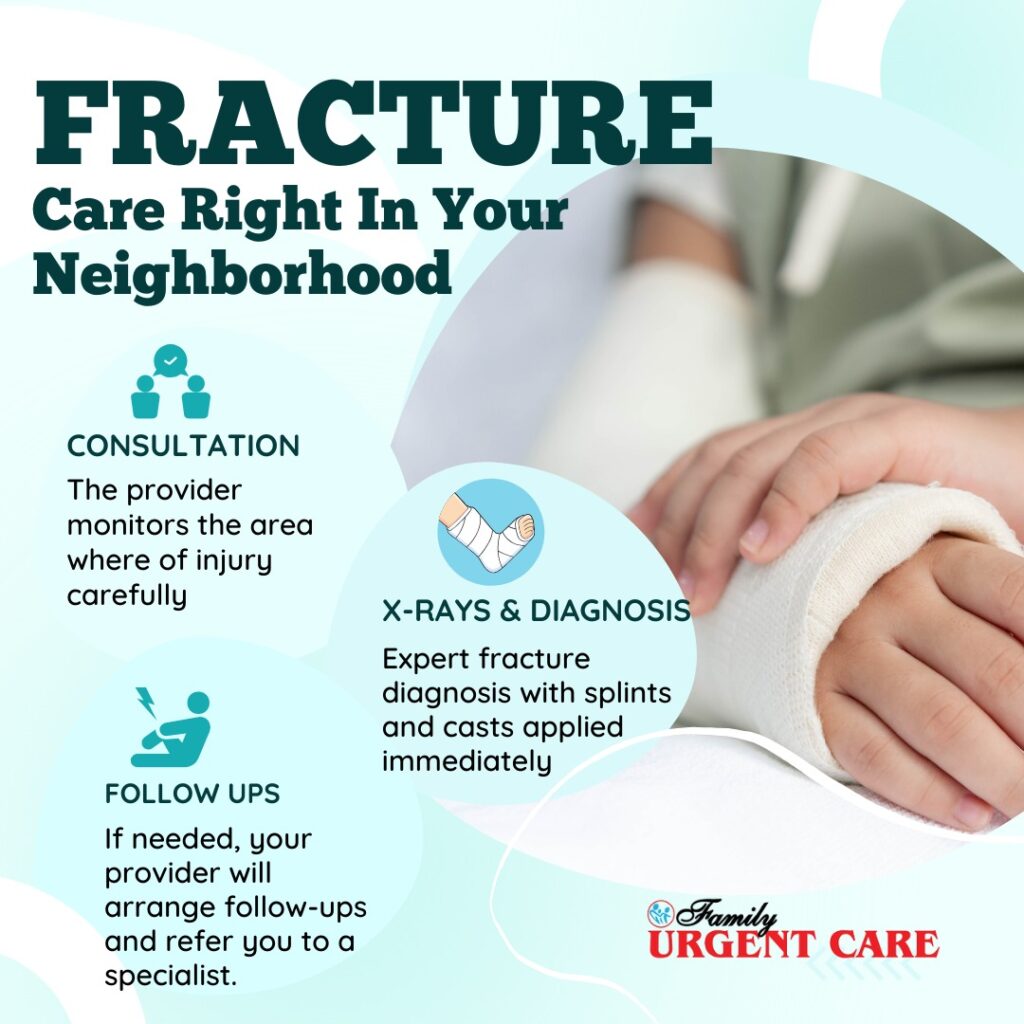Get Expert Medical Care For Quick Recovery of Fracture & Dislocations
From sports mishaps to everyday stumbles or accidental falls, fractures can happen anywhere and anytime. While some minor fractures aren’t severe, broken bones need complete bed rest and a lot of care.
So, whether you get hit in sports or perhaps you had an accidental fall, it is better to consult a healthcare professional right away.
At Family Urgent Care, our dedicated team of healthcare providers and doctors is committed to providing prompt and compassionate care when you suffer from minor fractures and dislocations.
So, visit us by booking an appointment or walking directly into the clinic and consulting our experienced doctors right away.
What Type Of Fractures Are Treated At An Urgent Care?
Urgent care centres are well-equipped with the right tools, supplies, machines and a trained medical staff to diagnose and treat various types of minor fractures and dislocations.
Some common types of fracture include:
- Stable fracture: This is a simple fracture in which a bone breaks but remains aligned and in its normal position. This is the most common type of fracture treated at urgent care facilities.
- Hairline fracture: This is also known as a partial or stress fracture and results in a crack or bruise within the bone. These fractures are often caused by repetitive stress or overuse, such as dancing, running or jumping.
- Closed fracture: When this occurs, your bone will break completely, but the skin surrounding the bone remains intact. You will feel severe pain, but the damage may not be noticeable.
- Greenstick fracture: In this type of fracture, the bone bends and breaks on only one side. If you or your child experiences this type of fracture, it is better to contact an emergency care facility.
- Compound fractures: This is also called an open fracture and it occurs when the skin barrier breaks along with the bone. You will typically see a piece of bone protruding from the skin. Compound fractures require an emergency care facility, so call 911 as soon as you see a person with an open fracture.
When to Go to Urgent Care vs. ER for Fractures?
Go to urgent care if: | Go to the ER if: |
Closed fracture without major deformity. | An open fracture where the skin barrier breaks along with the bone. |
Mild to moderate pain that you can manage with immobilization and OTC pain relievers. | Severe pain & swelling that cannot be controlled. |
Swelling and bruising, but no signs of nerve or circulation problems. | Numbness, tingling, loss of movement, or pale/blue fingers or toes. |
Suspected minor fractures in fingers, toes, hand, wrist, ankle, or foot. | Multiple fractures or trauma (e.g., car accident, fall from height). |
What Are The Symptoms Of Minor Fractures?
Symptoms of minor fractures, also known as hairline fractures or stress fractures, can vary depending on the location and severity of the injury. However, common symptoms may include:
- Pain: You’ll feel mild to moderate pain at the site of fracture in the hairline or stress fractures, which might improve with rest.
- Swelling: There is a noticeable localized swelling around the area of the fracture.
- Bruising: Mild bruising or discolouration may be present
Localized warmth & tenderness: The area around the fracture may feel warm and tender to the touch. - Difficulty bearing weight: Depending on the location of the fracture, there may be discomfort or difficulty when you try to lift some weight.
- Limited range of motion: You might feel difficulty in moving due to pain and swelling.
Minor fractures may seem less serious to many people, but they need proper diagnosis and treatment for proper healing. Therefore, if you experience any of the symptoms mentioned above, you can contact Family Urgent Care for an appropriate evaluation and treatment.
How Family Urgent Care Can Help With Minor Fractures?

We know that fractures and dislocations can seem scary! Fret not! Once you seek professional help as soon as you get injured, you can increase your chances of healing the bone faster and prevent future complications.
With our in-house X-ray machine, the doctor can assess the location of the fracture and its severity. After a proper evaluation and diagnosis, our doctors will immobilize the affected limb using a splint, brace or cast.
Last but not least, we might also book follow-up appointments, which include monitoring the healing process and making adjustments to the treatment plan. If necessary, patients may also be advised to consult an orthopedic specialist for additional evaluation and management.
So, ready to take the first step toward your recovery today? Contact us to schedule a consultation with our experienced doctors or walk into our clinic for prompt treatment.
FAQs
Yes, Benadryl (diphenhydramine) is an over-the-counter antihistamine that can help reduce itching, swelling, and allergic reactions from bug bites. However, if symptoms persist or worsen, it's best to visit a clinic for proper care.
Yes. Most urgent care clinics provide same-day fracture treatment. They can:
- Take X-rays
- Splint or cast the fracture
- Prescribe pain medication
- Refer you to an orthopedic specialist if needed
This makes urgent care a convenient option for many minor to moderate fractures. For severe injuries (like open fractures or hip fractures), go to the ER.
If you think you’ve broken a bone:
- Immobilize the area: Don’t move the injured part. Use a splint if possible.
- Apply ice for 15 – 20 minutes at a time to reduce swelling.
- Keep the injury raised above heart level if possible.
- Avoid putting weight on the area.
- Go to urgent care or the ER, depending on severity.
Do not try to straighten the bone yourself. Quick medical attention gives the best chance for proper healing.

